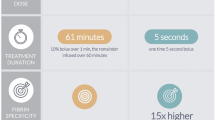Abstract
Tenecteplase, a mutant form of alteplase, possesses pharmacological properties that might favor its use for emergent fibrinolysis of acute pulmonary embolism. Contemporaneous search of the World’s literature reveals 14 humans with acute pulmonary embolism treated with tenecteplase. Here, we summarize those cases and report the presentation features, dosing details and outcomes of eight additional patients with acute pulmonary embolism treated with tenecteplase in an academic emergency department. None of our eight patients had a significant hemorrhagic event after tenecteplase, and the outcomes of all eight appear to be acceptable. Taken together, we submit that the present case report and prior case reports are sufficient to comprise a phase I study of the safety and efficacy of tenecteplase to treat acute pulmonary embolism.
Similar content being viewed by others
References
Dunn CJ, Goa KL (2001) Tenecteplase: a review of its pharmacology and therapeutic efficacy in patients with acute myocardial infarction. [Review] [68 refs]. Am J Cardiovas Drugs 1(1):51–66
Tanswell P, Modi N, Combs D et al (2002) Pharmacokinetics and pharmacodynamics of tenecteplase in fibrinolytic therapy of acute myocardial infarction. [Review] [64 refs]. Clinical Pharmacokinetics 41(15):1229–1245
Goldhaber SZ, Feldstein ML, Sors H (1994) Two trials of reduced bolus alteplase in the treatment of pulmonary embolism. An overview. Chest 106:725–726
Goldhaber SZ, Agnelli G, Levine MN (1994) Reduced dose bolus alteplase vs conventional alteplase infusion for pulmonary embolism thrombolysis: an international multicenter randomized trial. Chest 106:718–724
Goldhaber SZ, Haire WD, Feldstein ML et al (1993) Alteplase versus heparin in acute pulmonary embolism: randomised trial assessing right-ventricular function and pulmonary perfusion. Lancet 341:507–511
Konstantinides S, Tiede N, Geibel A et al (1998) Comparison of alteplase versus heparin for resolution of major pulmonary emoblism. Am J Cardiol 82(8):966–970
Konstantinides S, Geibel A, Heusel G et al (2002) Heparin plus alteplase compared with heparin alone in patients with submassive pulmonary embolism. The New England J Med 347(15):1143–1150
Thabut G, Logeart D (2005) Thrombolysis for pulmonary embolism in patients with right ventricular dysfunction: con. [comment]. [Review] [39 refs]. Arch Int Med 165(19):2200–2203
Wan S, Quinlan DJ, Agnelli G, et al (2004) Thrombolysis compared with heparin for the initial treatment of pulmonary embolism: a meta-analysis of the randomized controlled trials. [see comment]. Circulation 110(6):744–749
Mascitelli L, Pezzetta F (2003) Thrombolysis in the treatment of submassive pulmonary embolism. [comment]. Arch Int Med 163(10):1238
Thabut G, Thabut D, Myers RP et al (2002) Thrombolytic therapy of pulmonary embolism: a meta-analysis. J Am College Cardiol 40(9):1660–1667
Sze DY, Carey MBL, Razavi MK (2001) Treatment of massive pulmonary embolus with catheter-directed tenecteplase. J Vasc Interv Radiol 12(12):1456–1457
Caldicott D, Parasivam S, Harding J et al (2002) Tenecteplase for massive pulmonary embolus. Resuscitation 55(2):211–213
Lapanun W, Walters DL, McCarthy J et al (2003) Major pulmonary embolism and shock. Persistent hypotension after thrombolysis treated with improvised mechanical fragmentation of thrombus. Med J Aust 179(9):495–496
Clement D, Loyant R, Labet T (2004) Tenecteplase and massive pulmonary embolus. Ann Fr Anesth Reanim 23(4):440–441
Livaditis IG, Paraschos M, Dimopoulos K (2004) Massive pulmonary embolism with ST elevation in leads V1–V3 and successful thrombolysis with tenecteplase. Heart (British Cardiac Society) 90(7):e41
Allocca G, Dall’Aglio V, Nicolosi GL (2005) [Tenecteplase for massive pulmonary embolism in a 92-year-old man]. Ital Heart J Suppl 6(6):390–393
Melzer C, Richter C, Rogalla P et al (2004) Tenecteplase for the treatment of massive and submassive pulmonary embolism. J Thromb Thrombolysis 18(1):47–50
Medford AR, Maskell NA (2005) Images in resuscitation: bruising after thrombolysis for massive pulmonary embolism (PE). Resuscitation 65(2):131–132
Abdulla W, Netter U (2005) Case report. Successful use of tenecteplase in massive pulmonary embolism with cardiopulmonary resuscitation immediately following tracheostomy. Acta Anaesthesiol Belg 56(2):179–182
Isma’eel H, Taher A, Alam S et al (2006) Massive pulmonary embolism in a Lebanese patient doubly heterozygous for MTHFR and Factor V Leiden presenting with syncope and treated with tenecteplase. J Thromb Thrombol 21(2):179–184
Connor A, Narendran P, Contractor H et al (2006) Radiological and electrocardiographic changes following thrombolysis for acute pulmonary embolism with haemodynamic compromise. Resuscitation 68(3):315–317
van Beek EJR, Charbonnier B, Meyer G et al (2000) Guidelines on diagnosis and management of acute pulmonary embolism. Eur Heart J 21(16):1301–1336
Kline JA, Hernandez J, Rose G et al (2006) Surrogate markers for adverse outcomes in normotensive patients with pulmonary embolism. Crit Care Med 34:2773–2180
Cannon CP, Gibson CM, McCabe CH et al (1998) TNK-tissue plasminogen activator compared with front-loaded alteplase in acute myocardial infarction: results of the TIMI 10B trial. Thrombolysis in Myocardial Infarction (TIMI) 10B Investigators. Circulation 98(25):2805–2814
Van de WF (1999) Single-bolus tenecteplase compared with front-loaded alteplase in acute myocardial infarction: the ASSENT-2 double-blind randomised trial. Assessment of the Safety and Efficacy of a New Thrombolytic Investigators. Lancet 354:716–722
Assessment of the Safety and Eficacy of a New Thrombolytic Regimen (ASSENT)-3 Investigators (2001) Efficacy and safety of tenecteplase in combination with enoxaparin, abciximab, or unfractionated heparin: the ASSENT-3 randomised trial in acute myocardial infarction. Lancet 358(9282):605–613
Author information
Authors and Affiliations
Corresponding author
Rights and permissions
About this article
Cite this article
Kline, J.A., Hernandez-Nino, J. & Jones, A.E. Tenecteplase to treat pulmonary embolism in the emergency department. J Thromb Thrombolysis 23, 101–105 (2007). https://doi.org/10.1007/s11239-006-9018-3
Published:
Issue Date:
DOI: https://doi.org/10.1007/s11239-006-9018-3




